Related Research Articles
Henry the Fowler was the Duke of Saxony from 912 and the King of East Francia from 919 until his death in 936. As the first non-Frankish king of East Francia, he established the Ottonian dynasty of kings and emperors, and he is generally considered to be the founder of the medieval German state, known until then as East Francia. An avid hunter, he obtained the epithet "the Fowler" because he was allegedly fixing his birding nets when messengers arrived to inform him that he was to be king.

Year 1078 (MLXXVIII) was a common year starting on Monday of the Julian calendar.

Lothair III, sometimes numbered Lothair II and also known as Lothair of Supplinburg, was Holy Roman Emperor from 1133 until his death. He was appointed Duke of Saxony in 1106 and elected King of Germany in 1125 before being crowned emperor in Rome. The son of the Saxon count Gebhard of Supplinburg, his reign was troubled by the constant intriguing of the Hohenstaufens, Duke Frederick II of Swabia and Duke Conrad of Franconia. He died while returning from a successful campaign against the Norman Kingdom of Sicily.
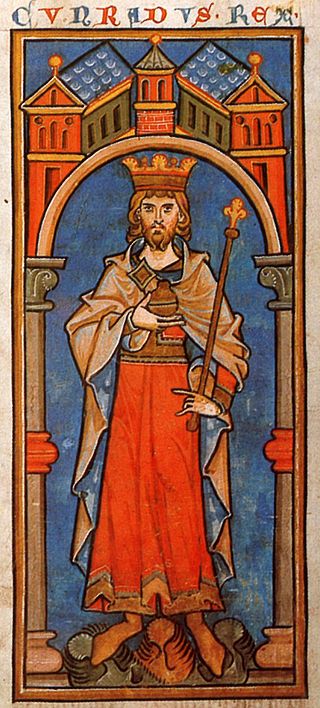
Conrad III of the Hohenstaufen dynasty was from 1116 to 1120 Duke of Franconia, from 1127 to 1135 anti-king of his predecessor Lothair III, and from 1138 until his death in 1152 King of the Romans in the Holy Roman Empire. He was the son of Duke Frederick I of Swabia and Agnes, a daughter of the Salian Emperor Henry IV.
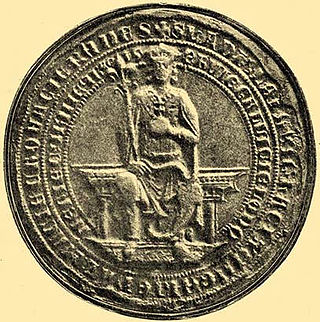
Ladislaus IV, also known as Ladislaus the Cuman, was King of Hungary and Croatia from 1272 to 1290. His mother, Elizabeth, was the daughter of a chieftain from the pagan Cumans who had settled in Hungary. At the age of seven, he married Elisabeth, a daughter of King Charles I of Sicily. Ladislaus was only 10 when a rebellious lord, Joachim Gutkeled, kidnapped and imprisoned him.
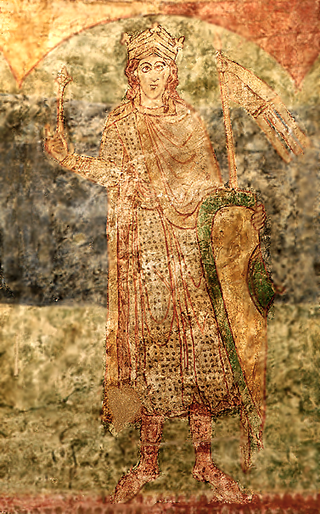
Vratislaus II, the son of Bretislaus I and Judith of Schweinfurt, was the first King of Bohemia as of 15 June 1085, his royal title granted as a lifetime honorific from Holy Roman Emperor Henry IV that did not establish a hereditary monarchy. Before his elevation to the royal dignity, Vratislaus had ruled Bohemia as duke since 1061.
The First Battle of Langensalza was fought on 9 June 1075 between forces of King Henry IV of Germany and several rebellious Saxon noblemen on the River Unstrut near Langensalza in Thuringia. The battle was a complete success for Henry, resulting in the subjugation of the Saxons shortly before the Investiture Controversy commenced. In Germany the battle is known as the Schlacht bei Homburg an der Unstrut, after a nearby Kaiserpfalz and monastery.
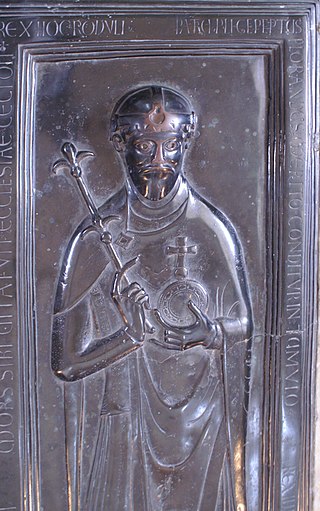
Rudolf of Rheinfelden was Duke of Swabia from 1057 to 1079. Initially a follower of his brother-in-law, the Salian emperor Henry IV, his election as German anti-king in 1077 marked the outbreak of the Great Saxon Revolt and the first phase of open conflict in the Investiture Controversy between Emperor and Papacy. After a series of armed conflicts, Rudolf succumbed to his injuries after his forces defeated Henry's in the Battle on the Elster.
Otto of Nordheim was Duke of Bavaria from 1061 until 1070. He was one of the leaders of the Saxon revolt of 1073–1075 and the Saxon revolt of 1077–1088 against King Henry IV of Germany.

Herman(n) of Salm, also known as Herman(n) of Luxembourg, the progenitor of the House of Salm, was Count of Salm and elected German anti-king from 1081 until his death.

The Saxon revolt was a civil war fought between 1077 and 1088, early in the history of the Holy Roman Empire. The revolt was led by a group of opportunistic German princes who elected as their figurehead the duke of Swabia, Rudolf of Rheinfeld, who became the anti-king. Rudolf was a two-way brother-in-law of the young Henry IV, Holy Roman Emperor, who had been crowned at the age of six and had taken the reins of power at age sixteen. The Great Revolt followed the Saxon Rebellion of 1073–75.

Battle on the Elster was the third and last battle between the Salian king Henry IV of Germany and anti-king Rudolf of Rheinfelden, fought on October 14, 1080 near Hohenmölsen on the White Elster river. Rudolf's forces were victorious; however, he was mortally wounded and succumbed to his injuries the next day.

The Battle of Flarcheim was fought between German king Henry IV and the German anti-king Rudolf of Swabia on January 27, 1080 near Flarchheim.

Otto I, traditionally known as Otto the Great, was East Frankish king from 936 and Holy Roman Emperor from 962 until his death in 973. He was the oldest son of Henry the Fowler and Matilda of Ringelheim.

Henry IV was Holy Roman Emperor from 1084 to 1105, King of Germany from 1054 to 1105, King of Italy and Burgundy from 1056 to 1105, and Duke of Bavaria from 1052 to 1054. He was the son of Henry III, Holy Roman Emperor—the second monarch of the Salian dynasty—and Agnes of Poitou. After his father's death on 5 October 1056, Henry was placed under his mother's guardianship. She made grants to German aristocrats to secure their support. Unlike her late husband, she could not control the election of the popes, thus the idea of the "liberty of the Church" strengthened during her rule. Taking advantage of her weakness, Archbishop Anno II of Cologne kidnapped Henry in April 1062. He administered Germany until Henry came of age in 1065.
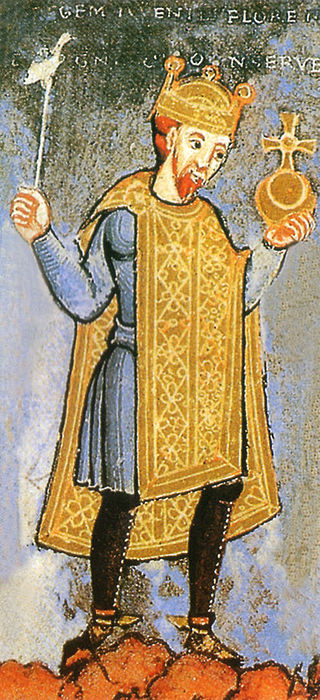
Henry III, called the Black or the Pious, was Holy Roman Emperor from 1046 until his death in 1056. A member of the Salian dynasty, he was the eldest son of Conrad II and Gisela of Swabia.

The Saxon revolt refers to the struggle between the Salian dynasty ruling the Holy Roman Empire and the rebel Saxons during the reign of Henry IV. The conflict reached its climax in the period from summer 1073 until the end of 1075, in a rebellion that involved several clashes of arms.

The Battle of Lenzen was a land battle between a Saxon army of the Kingdom of Germany and the armies of the Slavic Redarii and Linonen peoples, that took place on 4 September 929 near the fortified Linonen stronghold of Lenzen in Brandenburg, Germany. The Saxon army, commanded by Saxon magnate Bernhard, destroyed a Slavic Redarii army. It marked the failure of Slavic attempts to resist German king Henry the Fowler's expansionism to the Elbe.

Battle of Pleichfeld, in 1086, was the last major battle of the Saxon revolt of 1077–1088, a nobles' rebellion against the emperor Henry IV in the Holy Roman Empire. The battle was a victory for the rebel forces.
Werner of Steusslingen was the archbishop of Magdeburg from 1063 until his death. His episcopate was dominated by the Investiture Contest. He was an ally of King Henry IV of Germany until 1073, when he joined the first Saxon revolt. Imprisoned in 1075 and released the following year, he joined the second Saxon revolt in 1077. He was killed at the battle of Mellrichstadt.
References
- ↑ Germany under Henry IV and Henry V, Z.N. Brooke, The Cambridge Medieval History, Vol. V, 140.
- ↑ Robinson, I. S. Henry IV of Germany 1056-1106. Cambridge University Press. p. 350. ISBN 0-521-54590-0.
- ↑ Gillingham, John (1999). "4 An Age of Expansion". In Maurice Hugh Keen (ed.). Medieval Warfare: A History . Oxford University Press. pp. 74–75. ISBN 0-19-820639-9 . Retrieved 18 January 2009.
Battle of Mellrichstadt.